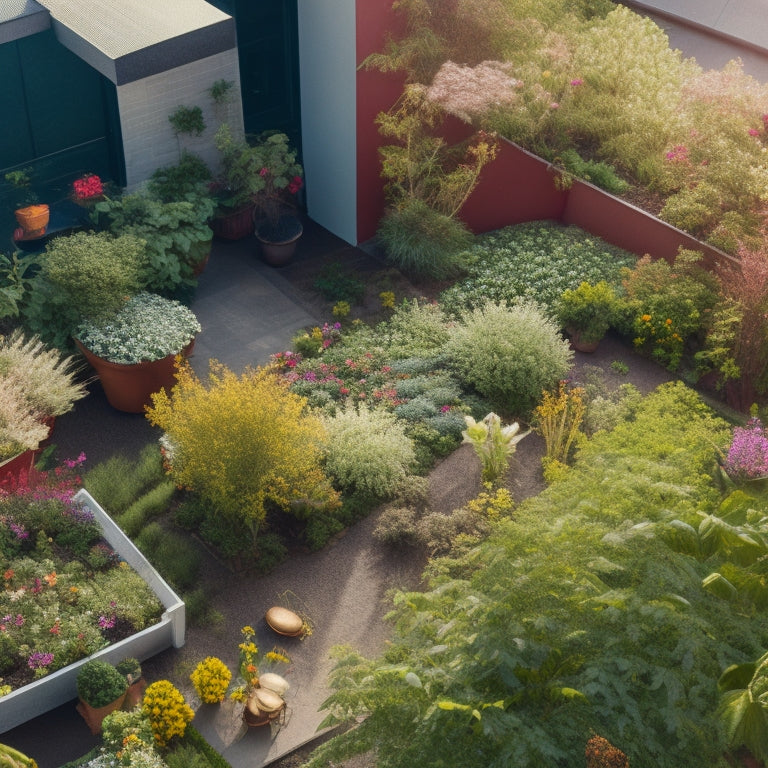
Why Pest Control Is Crucial for Rooftop Gardens
Share
You've invested significant time and resources into creating a thriving rooftop garden, but nearly 40% of rooftop gardens are vulnerable to pest infestations that can destroy your hard work in a matter of weeks. As you maintain your rooftop oasis, it's essential to prioritize pest control to prevent curled leaves, yellowing, and webbing caused by aphids, whiteflies, spider mites, and mealybugs. Without proper control, these pests can quickly spread and wreak havoc on your garden. By understanding the common pests, control methods, and regular monitoring, you'll be better equipped to safeguard your rooftop haven - and discovering the right strategies for your garden starts here.
Key Takeaways
• Regular pest control helps prevent damage to rooftop gardens, ensuring healthy plants and maximizing space utilization.
• Pests can quickly spread in rooftop gardens, making early detection and control crucial to prevent infestations.
• Uncontrolled pests can lead to the collapse of entire ecosystems, causing significant financial and environmental losses.
• Effective pest control methods promote a balanced ecosystem, encouraging beneficial insects and reducing chemical pesticide reliance.
• Neglecting pest control in rooftop gardens can result in the spread of pests to neighboring buildings and the local environment.
Common Pests in Rooftop Gardens
Rooftop gardens, with their unique microclimates and elevated locations, attract a distinct set of pests that can quickly overrun your carefully tended plants.
To protect your rooftop oasis, it's crucial to be aware of the common pests that can cause harm. You'll need to employ effective pest identification techniques to detect these unwanted visitors before they wreak havoc.
One of the most common pests you'll encounter is the aphid, which can cause curled or distorted leaves. Whiteflies, spider mites, and mealybugs are also frequent visitors, leaving behind telltale signs of pest damage such as yellowing leaves, webbing, or cottony patches.
To identify these pests, inspect your plants regularly, looking for signs of infestation like holes, discoloration, or actual pests on the leaves or stems.
Physical Barriers for Pest Control
When it comes to protecting your rooftop garden from pests, you'll want to contemplate implementing physical barriers to prevent infestations.
You can start by using screened planters or fine mesh netting to keep insects out, and make sure to seal any plant saucers to prevent pests from crawling in.
Screened Planters Work
By incorporating screened planters into your rooftop garden design, you effectively create a physical barrier that prevents pests from jumping, flying, or crawling into your plants. This is a highly effective pest prevention strategy that can be integrated into your overall rooftop garden design.
Screened planters offer several benefits, including keeping out larger pests like rabbits and deer, while also preventing smaller pests like aphids and whiteflies from reaching your plants. Additionally, screened planters can help reduce the risk of soil-borne diseases and nematodes.
By using screened planters, you can greatly reduce the need for pesticides and other chemicals, creating a safer and more sustainable gardening environment. Moreover, screened planters can also help improve air circulation and reduce moisture buildup, which can lead to healthier plants and reduced risk of fungal diseases.
Fine Mesh Netting
You can take your pest control to the next level with fine mesh netting, a physical barrier that allows plants to receive essential sunlight and air while keeping pests out. This is an excellent addition to your rooftop garden, as it provides a range of benefits.
One of the most significant mesh benefits is that it's an effective deterrent against whiteflies, aphids, and other small pests that can quickly destroy your crops.
When it comes to installation, keep the following tips in mind:
-
Install the mesh netting at least 6 inches above the plants to guarantee good air circulation and sunlight penetration.
-
Use a sturdy frame to support the mesh, as it can be prone to sagging over time.
-
Make sure the mesh is tightly secured to prevent pests from finding their way underneath.
Sealed Plant Saucers
In addition to fine mesh netting, sealed plant saucers provide another physical barrier to prevent pests from reaching your rooftop garden, this time at the soil level.
By installing sealed saucers under your planters, you create an impermeable layer that stops pests like slugs, snails, and insects from crawling up into your garden. This barrier also prevents weeds from growing, reducing competition for water and nutrients.
Sealed plant saucers also improve drainage efficiency by allowing excess water to escape, reducing waterlogged soil conditions that can attract pests. Moreover, they enhance moisture retention by preventing water from seeping out, guaranteeing your plants receive the right amount of moisture. This results in healthier plants that are less susceptible to pest damage.
When choosing sealed plant saucers, look for ones made from durable materials that can withstand harsh rooftop conditions. Confirm they fit snugly under your planters and are easy to clean to prevent debris buildup.
Organic Pest Control Methods
Effective rooftop garden management hinges on adopting organic pest control methods that harness nature's own defense mechanisms to combat unwanted critters. You can create a balanced ecosystem that discourages pests from thriving in the first place.
By focusing on soil health, you'll be well on your way to a pest-free rooftop garden. Healthy soil is teeming with beneficial microorganisms that help break down organic matter, making it difficult for pests to establish themselves.
To take your organic pest control strategy to the next level, consider the following approaches:
-
Companion planting: Pairing certain plants together can deter pests. For example, basil repels aphids and other pests that target vegetables.
-
Introduce beneficial insects: Ladybugs and lacewings are natural predators of common rooftop garden pests like aphids and whiteflies.
-
Use neem oil: Derived from the seeds of the neem tree, neem oil is a natural insecticide that can be used to control a wide range of pests.
Chemical Pest Control Options
Turning to chemical pest control options, rooftop gardeners can utilize synthetic or natural-based products to eliminate pest populations quickly, but with caution, as these methods can have unintended consequences on the ecosystem. When considering chemical pest control, it is important to prioritize chemical safety and responsible pesticide application. This means carefully reading product labels, following instructions, and taking necessary precautions to avoid exposure.
Here are some common chemical pest control options for rooftop gardens:
| Product Type | Active Ingredient | Target Pest |
|---|---|---|
| Insecticidal soap | Potassium lauryl sulfate | Soft-bodied insects |
| Neem oil | Azadirachtin | Insect larvae, mites |
| Pyrethrin spray | Pyrethrin | Flying insects, mosquitoes |
| Bifenthrin granules | Bifenthrin | Ants, roaches, fleas |
| Copper-based fungicides | Copper oxychloride | Fungal diseases |
When using chemical pest control methods, remember to always follow the product instructions, take necessary safety precautions, and consider the potential impact on beneficial insects and the environment.
Biological Pest Control Strategies
As you consider biological pest control strategies for your rooftop garden, you'll want to explore methods that harness the power of natural predators and beneficial organisms.
By encouraging these helpful species, you can create a balanced ecosystem that minimizes pest populations.
You'll learn how to implement natural predator encouragement and integrated pest management techniques to keep your garden thriving.
Natural Predator Encouragement
By incorporating native plants and reducing pesticide use, you can create an environment that fosters natural predator populations, ultimately reducing pest infestations in your rooftop garden. This approach not only benefits your garden but also contributes to the preservation of local ecosystems.
To create a haven for natural predators, consider the following strategies:
-
Preserve natural habitats: Leave some areas of your rooftop garden unmanicured, as these spaces can serve as shelter for beneficial insects.
-
Provide food sources: Incorporate plants that produce nectar, pollen, or seeds, which attract beneficial insects and support their survival.
-
Create a diverse landscape: Incorporate a variety of plants with different heights, textures, and bloom times to attract a range of beneficial insects and support their coexistence.
Integrated Pest Management
You can further reinforce your rooftop garden's natural defense system by implementing Integrated Pest Management (IPM) strategies that harness the power of biological pest control agents to target specific pests.
This multi-faceted approach involves identifying pest species, evaluating their populations, and introducing natural enemies to regulate their numbers. Effective pest identification strategies are essential in IPM, as they enable you to pinpoint the most vulnerable stages of a pest's life cycle and deploy targeted control methods.
For instance, introducing beneficial insects like ladybugs or lacewings can decimate aphid populations, while parasitic wasps can control whitefly infestations. By combining IPM with sustainable gardening practices, you can create a balanced ecosystem that minimizes the reliance on chemical pesticides.
This not only protects the environment but also preserves the biodiversity of your rooftop garden. By adopting IPM strategies, you'll be well on your way to creating a thriving, pest-resistant oasis that requires minimal maintenance and intervention.
Cultural Pest Control Techniques
Many rooftop gardeners adopt cultural pest control techniques, which involve modifying gardening practices to prevent pest infestations, as they offer a non-toxic and environmentally friendly approach to managing pests.
By incorporating these practices into your rooftop garden, you'll not only reduce the risk of pest infestations but also promote sustainable gardening.
Some cultural practices you can adopt include:
-
Crop selection: Choose varieties that are resistant to pests or have natural defense mechanisms, reducing the need for pesticides.
-
Soil health management: Maintain healthy soil through proper irrigation, aeration, and nutrient management, which can help prevent pest infestations.
-
Pruning and sanitation: Regularly prune plants to promote air circulation and remove infested or diseased areas, reducing the spread of pests.
Monitoring for Pest Infestations
Regular monitoring of your rooftop garden is essential to detecting pest infestations early, allowing you to take swift action and prevent their spread.
As you inspect your plants, look for signs of damage or stress, such as holes, discoloration, or wilting. Check for eggs, larvae, or actual pests on leaves, stems, and soil. You can also use sticky traps or bait stations to capture and identify pests.
Familiarize yourself with pest identification techniques, such as observing body shape, color, and behavior, to accurately determine the type of pest you're dealing with. This knowledge will help you choose the most effective infestation prevention strategies.
Set a regular monitoring schedule, ideally weekly, to catch potential issues before they escalate. Keep records of your observations, including the type of pest, its location, and the actions you take. This will help you track the effectiveness of your management strategies and make adjustments as needed.
Frequently Asked Questions
Can Rooftop Gardens Be Completely Pest-Free With Proper Control Measures?
You can considerably minimize pest issues in your rooftop garden by implementing effective pest prevention strategies and utilizing organic pest solutions, but achieving complete pest-free status is unlikely, as pests can be introduced through various means.
Do Pest Control Methods Affect the Growth of Rooftop Garden Plants?
"As you delicately drape dripping droplets of water on your rooftop garden, you wonder: do pest control methods affect plant growth? Yes, they can; harsh chemicals can harm plant health, while gentle approaches mitigate pest impact, ensuring thriving blooms."
Are There Any Pest Control Methods Safe for Rooftop Garden Wildlife?
You'll find that using natural repellents and introducing beneficial insects, like ladybugs and lacewings, are safe and effective pest control methods for rooftop gardens, allowing you to protect wildlife while maintaining a healthy ecosystem.
How Often Should Rooftop Gardens Be Inspected for Pest Infestations?
You'll need to implement regular pest detection techniques, inspecting your rooftop garden every 1-2 weeks during peak growing seasons and monthly during dormant periods to guarantee timely pest detection and effective inspection frequency.
Can Rooftop Garden Pest Control Be a DIY Task or Require Professionals?
You can attempt DIY pest control, but it's often ineffective; consider hiring professional services for a thorough approach, ensuring accurate identification and targeted treatments to prevent infestations and mitigate risks.
Related Posts
-

3 Best Space-Saving Gardening Ideas for Urban Renters
You can turn even the smallest urban space into a lush oasis by utilizing clever space-saving gardening ideas. Maximi...
-

3 Best Space-Saving Gardening Ideas for Urban Renters
You can turn even the smallest urban space into a lush oasis by utilizing clever space-saving gardening ideas. Maximi...
-

3 Best Space-Saving Gardening Ideas for Urban Renters
You can turn even the smallest urban space into a lush oasis by utilizing clever space-saving gardening ideas. Maximi...
-

3 Best Space-Saving Gardening Ideas for Urban Renters
You can turn even the smallest urban space into a lush oasis by utilizing clever space-saving gardening ideas. Maximi...
-

3 Best Space-Saving Gardening Ideas for Urban Renters
You can turn even the smallest urban space into a lush oasis by utilizing clever space-saving gardening ideas. Maximi...
-

3 Best Space-Saving Gardening Ideas for Urban Renters
You can turn even the smallest urban space into a lush oasis by utilizing clever space-saving gardening ideas. Maximi...
-

3 Best Space-Saving Gardening Ideas for Urban Renters
You can turn even the smallest urban space into a lush oasis by utilizing clever space-saving gardening ideas. Maximi...
-

3 Best Space-Saving Gardening Ideas for Urban Renters
You can turn even the smallest urban space into a lush oasis by utilizing clever space-saving gardening ideas. Maximi...
-

3 Best Space-Saving Gardening Ideas for Urban Renters
You can turn even the smallest urban space into a lush oasis by utilizing clever space-saving gardening ideas. Maximi...
-

3 Best Space-Saving Gardening Ideas for Urban Renters
You can turn even the smallest urban space into a lush oasis by utilizing clever space-saving gardening ideas. Maximi...
-

3 Best Space-Saving Gardening Ideas for Urban Renters
You can turn even the smallest urban space into a lush oasis by utilizing clever space-saving gardening ideas. Maximi...
-

3 Best Space-Saving Gardening Ideas for Urban Renters
You can turn even the smallest urban space into a lush oasis by utilizing clever space-saving gardening ideas. Maximi...
-

3 Best Space-Saving Gardening Ideas for Urban Renters
You can turn even the smallest urban space into a lush oasis by utilizing clever space-saving gardening ideas. Maximi...
-

3 Best Space-Saving Gardening Ideas for Urban Renters
You can turn even the smallest urban space into a lush oasis by utilizing clever space-saving gardening ideas. Maximi...
-

10 Best Shade Garden Planters Using Concrete Blocks
You're about to discover the perfect way to add industrial chic to your shade garden while ensuring healthy plant gro...
-

10 Best Shade Garden Planters Using Concrete Blocks
You're about to discover the perfect way to add industrial chic to your shade garden while ensuring healthy plant gro...
-

10 Best Shade Garden Planters Using Concrete Blocks
You're about to discover the perfect way to add industrial chic to your shade garden while ensuring healthy plant gro...
-

10 Best Shade Garden Planters Using Concrete Blocks
You're about to discover the perfect way to add industrial chic to your shade garden while ensuring healthy plant gro...
-

10 Best Shade Garden Planters Using Concrete Blocks
You're about to discover the perfect way to add industrial chic to your shade garden while ensuring healthy plant gro...
-

10 Best Shade Garden Planters Using Concrete Blocks
You're about to discover the perfect way to add industrial chic to your shade garden while ensuring healthy plant gro...
-

10 Best Shade Garden Planters Using Concrete Blocks
You're about to discover the perfect way to add industrial chic to your shade garden while ensuring healthy plant gro...
-

10 Best Shade Garden Planters Using Concrete Blocks
You're about to discover the perfect way to add industrial chic to your shade garden while ensuring healthy plant gro...
-

10 Best Shade Garden Planters Using Concrete Blocks
You're about to discover the perfect way to add industrial chic to your shade garden while ensuring healthy plant gro...
-

10 Best Shade Garden Planters Using Concrete Blocks
You're about to discover the perfect way to add industrial chic to your shade garden while ensuring healthy plant gro...
-

10 Best Shade Garden Planters Using Concrete Blocks
You're about to discover the perfect way to add industrial chic to your shade garden while ensuring healthy plant gro...
-

10 Best Shade Garden Planters Using Concrete Blocks
You're about to discover the perfect way to add industrial chic to your shade garden while ensuring healthy plant gro...
-

10 Best Shade Garden Planters Using Concrete Blocks
You're about to discover the perfect way to add industrial chic to your shade garden while ensuring healthy plant gro...
-

10 Best Shade Garden Planters Using Concrete Blocks
You're about to discover the perfect way to add industrial chic to your shade garden while ensuring healthy plant gro...
-

10 Best Shade Garden Planters Using Concrete Blocks
You're about to discover the perfect way to add industrial chic to your shade garden while ensuring healthy plant gro...
-

10 Best Shade Garden Planters Using Concrete Blocks
You're about to discover the perfect way to add industrial chic to your shade garden while ensuring healthy plant gro...
-

10 Best Shade Garden Planters Using Concrete Blocks
You're about to discover the perfect way to add industrial chic to your shade garden while ensuring healthy plant gro...
-

10 Best Shade Garden Planters Using Concrete Blocks
You're about to discover the perfect way to add industrial chic to your shade garden while ensuring healthy plant gro...
-

10 Best Shade Garden Planters Using Concrete Blocks
You're about to discover the perfect way to add industrial chic to your shade garden while ensuring healthy plant gro...
-

10 Best Shade Garden Planters Using Concrete Blocks
You're about to discover the perfect way to add industrial chic to your shade garden while ensuring healthy plant gro...
-

10 Best Shade Garden Planters Using Concrete Blocks
You're about to discover the perfect way to add industrial chic to your shade garden while ensuring healthy plant gro...
-

10 Best Shade Garden Planters Using Concrete Blocks
You're about to discover the perfect way to add industrial chic to your shade garden while ensuring healthy plant gro...
-

10 Best Shade Garden Planters Using Concrete Blocks
You're about to discover the perfect way to add industrial chic to your shade garden while ensuring healthy plant gro...
-

10 Best Shade Garden Planters Using Concrete Blocks
You're about to discover the perfect way to add industrial chic to your shade garden while ensuring healthy plant gro...
-

10 Best Shade Garden Planters Using Concrete Blocks
You're about to discover the perfect way to add industrial chic to your shade garden while ensuring healthy plant gro...
-

10 Best Shade Garden Planters Using Concrete Blocks
You're about to discover the perfect way to add industrial chic to your shade garden while ensuring healthy plant gro...
-

10 Best Shade Garden Planters Using Concrete Blocks
You're about to discover the perfect way to add industrial chic to your shade garden while ensuring healthy plant gro...
-

10 Best Shade Garden Planters Using Concrete Blocks
You're about to discover the perfect way to add industrial chic to your shade garden while ensuring healthy plant gro...
-

10 Best Shade Garden Planters Using Concrete Blocks
You're about to discover the perfect way to add industrial chic to your shade garden while ensuring healthy plant gro...
-

10 Best Shade Garden Planters Using Concrete Blocks
You're about to discover the perfect way to add industrial chic to your shade garden while ensuring healthy plant gro...
-

10 Best Shade Garden Planters Using Concrete Blocks
You're about to discover the perfect way to add industrial chic to your shade garden while ensuring healthy plant gro...
-

10 Best Shade Garden Planters Using Concrete Blocks
You're about to discover the perfect way to add industrial chic to your shade garden while ensuring healthy plant gro...
-

10 Best Shade Garden Planters Using Concrete Blocks
You're about to discover the perfect way to add industrial chic to your shade garden while ensuring healthy plant gro...
-

10 Best Shade Garden Planters Using Concrete Blocks
You're about to discover the perfect way to add industrial chic to your shade garden while ensuring healthy plant gro...
-

10 Best Shade Garden Planters Using Concrete Blocks
You're about to discover the perfect way to add industrial chic to your shade garden while ensuring healthy plant gro...
-

Succulent-Friendly Drainage Solutions for Block Planters
You can create a succulent-friendly drainage system in your cinder block planters by drilling holes in the bottom of ...
-

Succulent-Friendly Drainage Solutions for Block Planters
You can create a succulent-friendly drainage system in your cinder block planters by drilling holes in the bottom of ...
-

Succulent-Friendly Drainage Solutions for Block Planters
You can create a succulent-friendly drainage system in your cinder block planters by drilling holes in the bottom of ...
-

Succulent-Friendly Drainage Solutions for Block Planters
You can create a succulent-friendly drainage system in your cinder block planters by drilling holes in the bottom of ...
-

Succulent-Friendly Drainage Solutions for Block Planters
You can create a succulent-friendly drainage system in your cinder block planters by drilling holes in the bottom of ...
-

Succulent-Friendly Drainage Solutions for Block Planters
You can create a succulent-friendly drainage system in your cinder block planters by drilling holes in the bottom of ...
-

Succulent-Friendly Drainage Solutions for Block Planters
You can create a succulent-friendly drainage system in your cinder block planters by drilling holes in the bottom of ...
-

Succulent-Friendly Drainage Solutions for Block Planters
You can create a succulent-friendly drainage system in your cinder block planters by drilling holes in the bottom of ...
-

Succulent-Friendly Drainage Solutions for Block Planters
You can create a succulent-friendly drainage system in your cinder block planters by drilling holes in the bottom of ...
-

Succulent-Friendly Drainage Solutions for Block Planters
You can create a succulent-friendly drainage system in your cinder block planters by drilling holes in the bottom of ...
-

Succulent-Friendly Drainage Solutions for Block Planters
You can create a succulent-friendly drainage system in your cinder block planters by drilling holes in the bottom of ...
-

Succulent-Friendly Drainage Solutions for Block Planters
You can create a succulent-friendly drainage system in your cinder block planters by drilling holes in the bottom of ...
-

Succulent-Friendly Drainage Solutions for Block Planters
You can create a succulent-friendly drainage system in your cinder block planters by drilling holes in the bottom of ...
-

Succulent-Friendly Drainage Solutions for Block Planters
You can create a succulent-friendly drainage system in your cinder block planters by drilling holes in the bottom of ...
-

Succulent-Friendly Drainage Solutions for Block Planters
You can create a succulent-friendly drainage system in your cinder block planters by drilling holes in the bottom of ...


